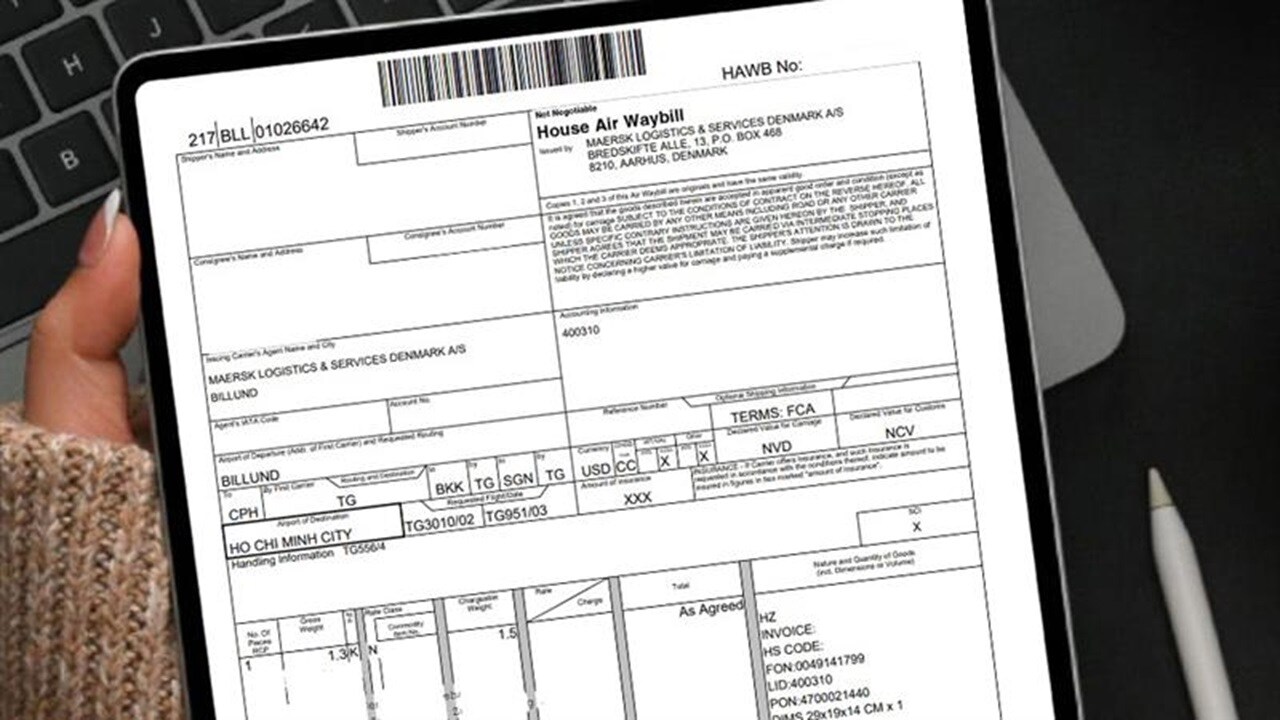Sending cargo by air? You’ll need an air waybill. Think of it like a boarding pass without which your goods cannot fly. In this article, we share the most important details you need to know about this crucial document when using air freight: its types and uses, the information it denotes, and more.
The air waybill (AWB), also known as an air consignment note, is a mandatory document in the air freight industry. It provides vital information about the journey, including:
AWB number (an 11-digit unique identification code)
Consignor (shipper) and consignee details (sender and receiver)
Origin and destination airports
Details of the airline carrier
Number of packages and weight
Description of the goods (like HS code, weight, dimensions, condition)
Declared value for customs
Special handling instructions (e.g., perishable goods, fragile items)
Payment information and insurance details

Tip: Unsure about the differences between ‘air freight’ and ‘air cargo’ or ‘a consignor’ and ‘a consignee’? Visit our Demystifying air freight terminology page.
Why is an AWB important in air freight?
A legally binding document governed by the International Air Transport Association (IATA) regulations, the completed AWB form serves multiple functions:
Receipt of goods: Confirmation that the airline has received the shipment from the consignor.
Contract of carriage: A legally binding agreement between consignor and carrier; it outlines the terms and conditions of transportation.
Details of shipment: Information on the goods being transported, including HS code, weight, quantity, declared value, destination, and consignee specifications.
Commercial invoice: Details the value of the goods for customs clearance and insurance purposes.
Tracking document: Enables shipment tracking throughout the journey for various stakeholders involved.
Note that an air waybill is a non-negotiable document. This means you cannot use it as a title of ownership to claim the goods or facilitate the transfer of goods between parties.
What is an air waybill used for?
Serves as a financial document for billing and insurance purposes.
Facilitates customs clearance to assess duties and taxes by customs authorities.
Protects all parties involved by outlining the rights and responsibilities of the consignor, carrier, and consignee – minimising the risk of disputes.
Provides accurate details about the shipment for invoicing purposes.
Enables dispute resolution by serving as legal documentation and evidence of the agreement between the parties.
Facilitates shipment tracking to track shipment’s progress in real-time with AWB number.
Features and formats: What are the colours of AWB?
A total of at least eight copies of an air waybill is issued. The first three copies are known as original bills, while the rest are copies. Each has its own colour code and purpose as depicted here:
Most AWBs adopt the above-mentioned colour format and feature airline-specific carrier logos.
Types of air waybills
There are two main types of AWBs, as follows:
| Feature | Master air waybill (MAWB) | House air waybill (HAWB) |
|---|---|---|
Issued by | Carrier airline | Freight forwarder |
Covers | Consolidated shipment (multiple individual shipments) | Individual shipment within a consolidated HAWB |
Acts as | Contract with airline for overall shipment | Contract between consignor (shipper) and forwarder |
Details included | Overview of consolidated shipment | Specific details of individual air freight shipment |
Use case | Ideal for bulk shipments with overall contract management with carrier | Suitable for smaller shipments with individual documentation and contract |
How does an air waybill differ from a sea waybill or an ocean bill of lading
Air waybills (AWBs) and sea waybills (SWBs) are non-negotiable documents serving as the receipt of goods. However, the AWB pertains only to air cargo transportation, whereas a sea waybill is used as a shipping document for ocean only. On the other hand, a bill of lading (B/L) is a negotiable document used primarily for ocean shipments. It acts as a document of title, allowing for ownership transfer and financing as well.
Here's an overview of the key differences between AWB, SWB, and B/L in more detail:
| Feature | Air Waybill (AWB) | Sea Waybill (SWB) | Ocean Bill of Lading (B/L) |
|---|---|---|---|
Mode of transportation | Air | Ocean | Ocean |
Negotiable | No | No | Yes |
Issued by | Airline | Carrier | Carrier |
Key functions | Receipt, contract, tracking | Receipt, contract, tracking | Receipt, contract, tracking, ownership transfer, and document of title |
Time of issuance | After goods are accepted for transportation | Before the shipment | Before or after the goods are shipped via ocean |
Information detail | Less detailed, primarily focusing on basic details like shipper, consignee, origin, destination, weight, volume, and commodity description | Similar to AWB in terms of detail, focusing on basic shipment information | More detailed, including specific information about the vessel, voyage number, port of loading, and port of discharge, in addition to basic shipment information |
Incoterms usage | Not used for FAS, FOB, CIF, and CFR (as these terms involve ownership transfer, which is not possible with non-negotiable documents) | Cannot be used with FAS, FOB, CIF, and CFR (same reason as for AWB) | Used with all Incoterms, as it transfers ownership of goods |
What is an electronic air waybill (e-AWB)?
An electronic air waybill, or e-AWB, is the digital equivalent of a conventional paper air waybill.
It serves as a contract of carriage between the shipper and the airline carrier, containing all the necessary shipment information. By using electronic data interchange (EDI) messages, e-AWBs enable seamless communication between all parties involved in the shipment, from the shipper to the carrier and customs authorities.
With the increasing digitisation of the logistics industry, electronic air waybills (e-AWBs) are becoming increasingly popular. An e-AWB has several advantages over traditional AWBs:
Faster processing: e-AWBs can be created and submitted electronically, significantly reducing processing times.
Improved accuracy: e-AWBs eliminate the risk of errors associated with manual data entry and misplacement.
Enhanced tracking: e-AWBs provide real-time tracking information, improving visibility throughout the supply chain.
Which type of AWB to choose will depend on the specific nature of your shipment, whether you’re using a freight forwarder, and your preferred document format (conventional or digital). IATA actively promotes e-AWB implementation globally.
How to book air freight?
The air waybill (AWB) isn’t just a shipping document — it’s the backbone of air freight logistics, ensuring the smooth movement of goods, proper handling, legal compliance, and tracking throughout your cargo’s journey.
To make the process seamless, partner with a reliable logistics provider that can guide you through creating accurate AWBs and navigating the complexities of air freight. With an in-house airline network, extensive expertise, and global coverage, Maersk offers end-to-end solutions to simplify your air freight shipping. Keep your goods moving with Standard Air Freight, Air Charter and Sea-Air Services – either by leveraging our own-controlled air freight network or our strategic partners with Maersk Air Freight.






